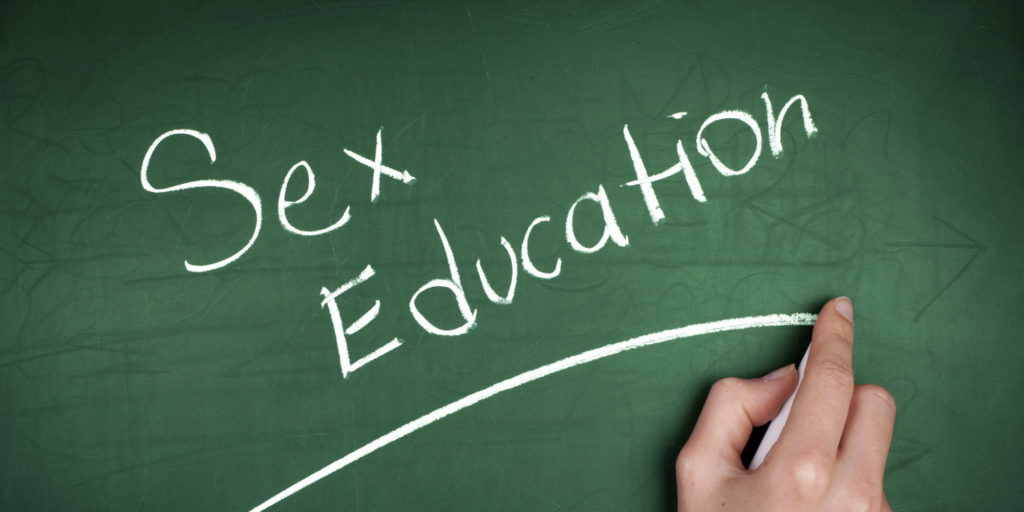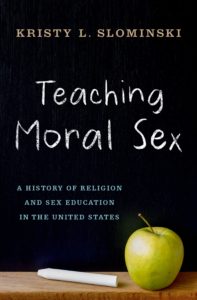Teaching America's Adolescents about Sex
A book excerpt from Teaching Moral Sex: A History of Religion and Sex Education in the United States
 The following excerpt comes from Kristy L. Slominski’s Teaching Moral Sex: A History of Religion and Sex Education in the United States (Oxford University Press). The book explores how religiously motivated groups and people shaped the history of sex education in the United States.
The following excerpt comes from Kristy L. Slominski’s Teaching Moral Sex: A History of Religion and Sex Education in the United States (Oxford University Press). The book explores how religiously motivated groups and people shaped the history of sex education in the United States.
This excerpt comes from the book’s introduction.
***
In 2019, evangelical psychologist James Dobson warned Colorado families that their “deeply held Christian convictions” were under attack. He was referring to a proposed bill to expand public school sex education programs, over which a heated debate had erupted in the state. Even though Colorado had previously banned abstinence-only education, the proposal to provide additional funding and add topics such as sexual consent to the already existing comprehensive sexuality education programs led to an outpouring of opposition and support. Letters flooded in, citizens drove to the capital to testify for and against the bill, and legislators gave emotional pleas on each side. Now, over fifty years after the initial round of the sex education controversies in the United States, the debate is alive and well between those advocating comprehensive sexuality education and those who promote abstinence-only education. Even though many curricula actually provide a mixture of progressive and conservative messages, strong alignments with either approach have caused rifts and cultural confusion over whether young Americans need more or less information about sex.
 Conservative evangelical Christians like James Dobson who championed the message of remaining abstinent until marriage have been the loudest religious voices within recent controversies, leading to the impression that “religion”—as if this were a unified concept—seeks to restrict sexual information. The association of sex education with the secular nature of public schools has contributed to this claim. However, a longer historical view challenges these simplifications, revealing that religious sex educators have shaped the movement for public sex education continuously since its roots in the late nineteenth-century United States. They co-founded the major organizations that guided sex education, including the American Social Hygiene Association (ASHA) in 1914 and the Sex Information and Education Council of the United States (SIECUS) in 1964. Since then, religious sex educators have worked continuously through or in partnership with these groups. Their advocacy paved the way for many types of sex education, some of which directly countered their goals for both religion and sexuality.
Conservative evangelical Christians like James Dobson who championed the message of remaining abstinent until marriage have been the loudest religious voices within recent controversies, leading to the impression that “religion”—as if this were a unified concept—seeks to restrict sexual information. The association of sex education with the secular nature of public schools has contributed to this claim. However, a longer historical view challenges these simplifications, revealing that religious sex educators have shaped the movement for public sex education continuously since its roots in the late nineteenth-century United States. They co-founded the major organizations that guided sex education, including the American Social Hygiene Association (ASHA) in 1914 and the Sex Information and Education Council of the United States (SIECUS) in 1964. Since then, religious sex educators have worked continuously through or in partnership with these groups. Their advocacy paved the way for many types of sex education, some of which directly countered their goals for both religion and sexuality.
Before conservative Christians launched a series of attacks on sex education in the late 1960s, religious liberals—primarily liberal Protestants—set the tone for religion within public sex education. Those motivated by liberal religious interpretations pushed sex education in new directions and into different public spaces, contributing to a number of substantial shifts in themes and instructional approaches. Ultimately, they created many of the terms on which recent sex education debates have been waged. Through engagement in sex education and acceptance as authorities on the moral dimensions of sexuality, they found opportunities to integrate their progressive religious worldviews and agendas with scientific and cultural understandings of sexuality. Encounters with medical and social scientific trends within sex education organizations inspired strategies for adapting Christianity to a quickly changing society, thereby showing its continued vitality.
The history of sex education therefore cannot be separated from the story of liberal Protestants in the United States. While some Protestant sex educators took part in more radical liberal religious movements such as Unitarianism and the Free Religious Association, most were of the moderate variety of Protestant liberalism affiliated with mainline denominations, especially those that became members of the Federal Council of the Churches of Christ in America (FCC) and its successor, the National Council of the Churches of Christ in the United States of America (NCC). With diverse Christian interpretations and motivations at the table, they found common ground in their interest in sex education as a way to guide children, strengthen marriages, and deepen America’s attention to morality. As liberal Protestants, they shared a commitment to adapting Christianity to modern culture. Anchoring their sex education work was a belief in the fundamental compatibility of religious and scientific truths and the ongoing revelation of God through the world over time. Because they believed God’s truths were revealed through both nature and society, science could help humans to know God better and social reform could bring about the Kingdom of God on Earth. Many were influenced by the social gospel, a loosely organized Christian movement committed to social reforms in order to fulfill this progressive religious vision for society. They promoted ecumenical cooperation and appreciated historical critical readings of the Bible that situated biblical truths within their historical contexts and literary genres. Liberal Protestant stances were increasingly defined in opposition to the Protestant fundamentalist movement, which distanced itself from other Christians, mainstream scientific authority, and selective dimensions of secular culture.
Liberal Protestant sex educators invoked moral frameworks to both expand instruction and inhibit sexual behavior, and these efforts, I argue, laid groundwork for the later emergence of both comprehensive sexuality education and abstinence-only education. While values deemed “liberal” and “conservative” within contemporary sex education disputes seem starkly opposed, that was not always the case. Throughout much of this history, contractive and expansive positions about sexuality were combined or existed alongside one another rather than being separated into opposing camps. Amalgamation was, in part, a way to gain cultural acceptance. Sex educators tempered more radical ideas of the time, including their basic goal of teaching sexual information to youth, with moderate and conservative messages, often strategically framing the former as in service to the latter. Religious language also softened the impersonal, detail-oriented terminology of science, which was sometimes viewed as too harsh or shocking for such a socially charged topic. Although scientifically trained sex educators argued that objective distance and precision could raise the subject out of the gutters and sanitize it, the question of obscenity continued to lurk near the surface. Liberal religious sex educators paired the “scientific exemption” that shielded most medical professionals from censorship on issues of sexuality with what I call the moral exemption that bolstered its protection as a topic addressed by respectable Christians.
Liberal religious people were well positioned to mediate the challenge of balancing change and continuity within sex education because of their interest in adapting religious traditions to modern conditions. They advanced conservative perspectives by teaching sex education as moral education and emphasizing premarital sexual purity, the restriction of sexual behavior to monogamous marriages between men and women, and the importance of framing sexuality by Christian family values. Attaching these stances to their cause leveraged significant cultural currency because the concept of families based around monogamous marriages had deep-seated connections to American culture. Through their prescriptive lessons, they also shaped constructions of heterosexuality and family life that took on hegemonic status by the mid-twentieth century. At the same time, religious sex educators developed progressive approaches that employed the concept of morality to promote frank public discourse, to broaden sexuality’s scope beyond physical intercourse, to advocate positive interpretations of sexuality, and to adapt to scientific advancements and societal changes. In the 1960s, some of them would also use the idea of the “new morality” to open conversations about sexual diversity.
Interest in morality, therefore, played a role in both progressive and restrictive impulses within the sex education movement. While religious sex educators were certainly not the only ones advocating the moral dimension of sex education—many educators and physicians echoed these interests—those who actively identified their sex education work with religion were most vocal and persistent in keeping morality tied to the cause of sex education. The framework of morality gained traction among scientific sex educators, many of whom were eager to disprove the notion that doctors condoned illicit sexual activity just because they offered “quick fixes” for preventing or treating venereal disease. A growing number of education experts within the movement, too, embraced it out of concern for developing morally responsible citizens.
 As a desire to shape moral behavior permeated sex education, religious people had a diffuse but powerful avenue for advancing their values, one that simultaneously helped them to convince churches that sex educators were moral reformers. Liberal religious sex educators’ broad framing of morality rested on their belief in the goodness of human nature and the capability of humans to strive toward ethical actions. Because they viewed God as immanent in nature and society, the Bible was treated as one source of moral authority among many, and its lessons needed to be understood within their original contexts and adapted in order to be most useful. For sex educators, morality took on new meanings in different settings, from the push for moral education about character building to the later situation ethics of the “new morality,” becoming a catchall for introducing various religious concerns into the movement. As religious studies scholar Anthony Petro noted in his study of Christian responses to AIDS, “Few words have the potential to carry as much authority or to be as rhetorically flexible as morality.” As such, it has become an important “site of translation” between the religious and the secular.
As a desire to shape moral behavior permeated sex education, religious people had a diffuse but powerful avenue for advancing their values, one that simultaneously helped them to convince churches that sex educators were moral reformers. Liberal religious sex educators’ broad framing of morality rested on their belief in the goodness of human nature and the capability of humans to strive toward ethical actions. Because they viewed God as immanent in nature and society, the Bible was treated as one source of moral authority among many, and its lessons needed to be understood within their original contexts and adapted in order to be most useful. For sex educators, morality took on new meanings in different settings, from the push for moral education about character building to the later situation ethics of the “new morality,” becoming a catchall for introducing various religious concerns into the movement. As religious studies scholar Anthony Petro noted in his study of Christian responses to AIDS, “Few words have the potential to carry as much authority or to be as rhetorically flexible as morality.” As such, it has become an important “site of translation” between the religious and the secular.
In addition to the concept of morality, the ideal of nonsectarian Christianity facilitated the introduction of religious concerns into secular versions of sex education. Instead of just secular and religious spheres, the liberal Protestants of early sex education divided their explicitly religious efforts further between nonsectarian and denominational work. The boundaries between these categories required ongoing negotiations, especially with the growing public awareness that “nonsectarian” approaches within public schools reflected strong Protestant biases and insufficiently accommodated Catholics and Jews—the religious “others” with whom Protestants most frequently interacted. Public schools became more associated with secularism as explicit religious exercises were increasingly removed in the early twentieth century. Because sex education faced a slow and rocky start in schools (with the exception of colleges), most sex education work occurred through nonsectarian voluntary organizations that promoted a general but predominantly liberal view of Christianity—and, by the mid-twentieth century, a “Judeo-Christian” notion of religion—with which they believed almost all people could agree. From this foundation of nonsectarian voluntary work, religious leaders then brought sex education to their churches and denominations, where more specific theologies influenced the topic of sexuality.
Liberal Protestant sex educators celebrated this trifold division of labor between the secular, the nonsectarian, and denominations, seeing each arena as complementary and necessary to the others. When engaging the broader public beyond specific churches, they balanced between secular and nonsectarian values that they viewed as broadly acceptable to guide the public; this was one of their answers to accommodating religious pluralism in a country that separated church and state. After the 1960s, complementarity and cooperation between these three areas of sex education could no longer be assumed as sex education began to grow within public schools, which became more wary of both denominational and nonsectarian religious approaches. These alignments redistributed more of the liberal religious sex education work into denominations, leaving a public void that conservative Christians would fill with abstinence-only education.
Nonsectarian Christian versions of sex education flourished within organizations like the Young Men’s Christian Association (YMCA), the Federal Council of Churches and its successor, the National Council of Churches, as well as through the military education provided by chaplains. Nonsectarian Christianity also operated quite freely within ASHA and the early days of SIECUS, mingling with and being supported by the scientific orientation of the movements. The strategy of masking Protestant distinctiveness in the framework of nonsectarian universality was an old one to gain religious consensus. In this case, it worked to integrate liberal Protestant values into a movement dominated by scientific professionals and education experts. At the same time, downplaying explicit markers of Protestantism such as theological doctrines, biblical passages, and evangelism in favor of general Christian ideas of morality and family values distanced sex educators from more conservative Protestants, who liberals scorned as promoting religious dogmas and the repression of sexuality.
Morality permeated many dimensions of sex education. Indeed, studies have noted a preoccupation with morals within every phase of its history, which underscores the need for research on religious involvement. However, scholars’ primary interest in professionals of science, public health, education, or the government has produced academic interpretations of morality as intrusive—a nuisance that tarnished secular plans. For example, in her history of the government’s hygiene campaigns, Alexandra Lord argued that moral frameworks prevented scientists and public health officials from effectively dealing with syphilis and gonorrhea. Many comprehensive sexuality educators, too, have reinforced this narrative, lumping morality with the abstinence-only work that runs counter to their goals. While moral considerations undoubtedly informed and complicated scientific treatment of venereal diseases and the teaching of public sex education, they also motivated many sex educators, spurred public interest, provided legitimacy in the context of obscenity charges and cultural silences, and situated sex education within a larger social matrix, expanding responsibility to individuals, parents, churches, schools, and government. By retelling the history of the sex education movement with a focus on religion, I contextualize morality’s entanglements with other agendas and elucidate its various uses and meanings. While morality was not merely a synonym for religion, religious representatives maintained a strong claim to be the moral experts of the movement and left an imprint of religion on the term.
Liberal religious sex educators sought to improve morality at the national level by acting outside of traditional religious institutions, as many Americans feared that churches were no longer the most effective instruments for influencing society. For Protestant sex educators, their work enacted the social gospel of building the Kingdom of God on earth through the improvement of society. Applying Christian messages to social problems beyond churches reaffirmed religion’s immediate significance. The work came full circle when Protestant sex educators brought the work back to their churches, transforming these institutions into tools for sex education. In the long term, however, religious contributors to the mainstream sex education movement created the terms of their own exit. By ceding certain authority to scientific experts and allowing denominations to take over the religious dimensions of sex education, liberal religious leadership in the secular realm of sex education became less visible.
Kristy Slominski is Assistant Professor of Religion, Science, and Health at the University of Arizona.
***
Interested in more on this topic? Check out our conversation with Kristy Slominski in episode 17 of the Revealer podcast: “Sex Education and Religion in Public Schools.”